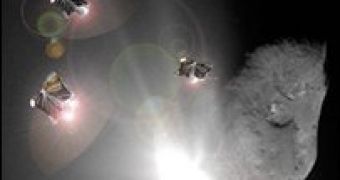A solution reminding us of the "Armageddon" movie and high-skilled drillers like Bruce Willis would help only as plan B. In fact, scientists are focusing on flying mirrors to save the Earth from a catastrophic asteroid collision.
No less than 5,000 mirrors would be necessary to focus a sunlight fascicle on to the asteroid, melting the rock and shifting its orbital route away from Earth. The proposal came after a research team at the University of Glasgow analyzed nine different methods of pushing out near earth objects (asteroids and comets).
Amongst the methods investigated by scientists there was also the nuclear explosion, assessing the risk of flying debris after an aggressive nuclear explosion to be too high for life on Earth.
A 100 m (300 ft) wide asteroid collides with the Earth once in a century. The orbiting mirrors would concentrate the sunlight on a side of the asteroid, rising its temperature to about 2,100 ?C.
This would push the asteroid off its course. Calculations showed that the orbit of an asteroid 150 m (500 ft) wide would be sufficiently changed by a group of 100 mirrors in a matter of days. For an asteroid the size of that suspected to have ended the dinosaur life 65 million years ago, a fleet made of 5,000 mirrors would furnish a beam doing its job in three or more years.
"Asteroid impacts are a real threat. The Tunguska explosion in 1908 devastated an area bigger than Greater London. With only 10 spacecraft flying in formation, each with a 20m mirror, we could deflect a similar size asteroid into a safe orbit in about six months. Our studies show that this technology is genuinely feasible." said lead researcher Dr Massimiliano Vasile. By now, the researchers are worried about Apophis, the potential Earth-colliding asteroid discovered in 2004 and having a width of 390 m (1,300 ft).
Apophis will miss the Blue Planet in 2029 just by 100,000 miles (160,000 km) but it could hit us when it swings by in 2036.

 14 DAY TRIAL //
14 DAY TRIAL //